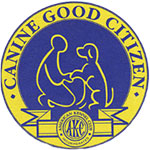The Canine Good Citizen Program
(American Kennel Club)

The Canine Good Citizen test
Demonstrating confidence and control, the dog must complete these ten tests:
- Accepting a friendly stranger demonstrates that the dog will allow a friendly stranger to approach in a natural everyday situation. The evaluator and handler shake hands and exchange pleasantries with the dog at the handlers side. The dog must show no sign of resentment or shyness and must not break position or try to go to the evaluator.
- Sitting politely for petting demonstrates that the dog will allow a friendly stranger to touch it. With the dog sitting at the handler's side, the evaluator pets the dog on the head and body, then circles the dog and handler, completing the test. The dog must not show shyness or resentment.
- Appearance and grooming demonstrates that the dog will welcome and allow grooming and examining by a stranger such as a groomer or veterinarian. The evaluator inspects the dog, then combs or brushes the dog and examines the ears and front feet.
- Out for a walk (on a loose leash) demonstrates that the handler has control of the dog.
The handler, with the dog at their side, must make a left turn, right turn and an about turn, with at least one stop in between and another at the end.
- Walking through a crowd demonstrates that the dog can move about politely in pedestrian traffic and is under control in public places. The dog and handler walk around and pass close to several people. The dog may show some interest, without appearing over-exuberant, shy or resentful.
- Sit and down command/staying in place demonstrates that the dog has training, will respond to the handler's command and will remain in place when commanded. The handler tells the dog to stay. Then the handler will walk forward the length of a 20-foot line. The dog must stay in place.
- Praise/Interaction demonstrates that the dog can be easily calmed following play or praise and can leave the area in a mannerly fashion. The handler plays with the dog using a toy or a favourite trick for ten seconds of play and then must calm the dog for the next exercise.
- Reaction to another dog demonstrates that the dog can behave politely around other dogs. Two handlers and their dogs approach each other from a distance of about ten yards, stop, shake hands and exchange pleasantries. Then each team walks away, continuing on for about five yards. The dogs should show no more than casual interest.
- Reaction to distractions demonstrates that the dog has confidence when faced with distractions such as a loud noise. Usually a large bell is rung behind the dog. The dog may express interest and curiosity and may appear slightly startled but should not panic, try to break away, show aggressiveness or bark.
- Supervised isolation demonstrates that the dog can be left alone if necessary and will maintain its training and good manners. The dog is attached to a six-foot line for three minutes while the handler leaves the area. The dog should not continually bark, whine, howl, pace or show anything other than mild agitation or nervousness.
The dogs that pass the test earn the title of Canine Good Citizen, their owners may place the initials CGC after their dog's name, and they receive a certificate.
|

